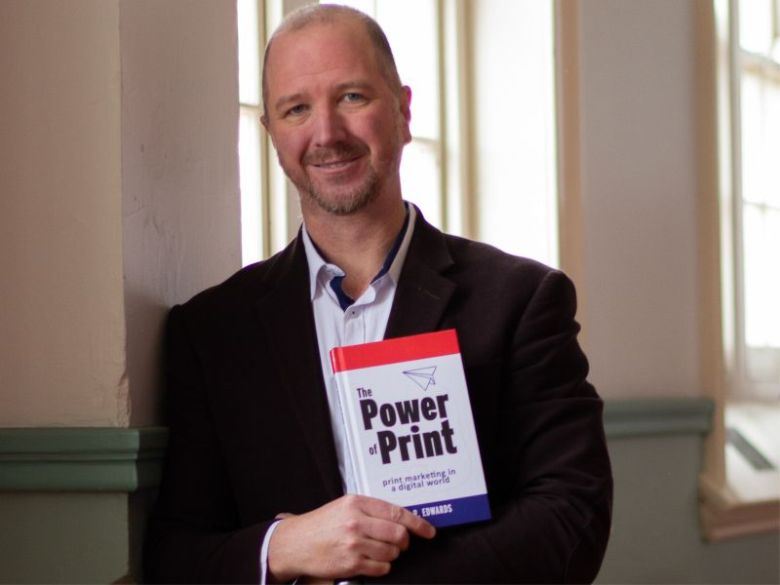
This article was written by Posterboy Printing’s Daniel Edwards
The day they closed the pubs for COVID lockdowns, my business ground to a halt.
My print business supported retailers and events. That all ended in an abundance of caution. Tens of thousands of dollars worth of jobs were cancelled that day.
The government put my business on life support shortly after and started paying my wages. I decided to write a book about print in my new spare. Writing, and home schooling, became my focus for the next 18 months or so.
I read a lot of studies from industry groups, and universities from around the world, taking copious notes. Organising and reorganising my thoughts. I scribbled ideas on index cards and spread them over the floors. I wrote and rewrote the chapters until I ended up with about 30,000 words worth of book and the Six Princples of Print.
The Architect
Meanwhile work was still trickling in, and a past customer, an architect, contacted me to do some business cards for his new staff member. I charged him the traditional, not enough to update his artwork with a new name, and sent him the updated art. He came back with a bunch of changes, and notes from his business coach on my artwork, asking for a complete redo and some creative options. He didn’t just want an update, he wanted a full rebrand and to reposition himself as a top tier architect. From the tone and number of changes, it was clear to me that he was uncertain about how he wanted his cards to look.
Three things stood out to me immediately.
1. This was way beyond the scope I had quoted.
2. If he wanted to rebrand as a bespoke high-end architect, he was wasting his time focusing on fonts and colour palettes.
3. I had just spent 18 months thinking about how to make print great.
With all that bubbling in my head, I decided to break the script I had been running for over a decade. The script that said, ‘I’m not a graphic designer, I’m not a copywriter, I’m not a marketer. I’m a printer. I get good output from my machines. I would focus the practical side of producing print, and on saving my customers money to get them good value. If you want a good print, give me good art’.
Instead, I told him what I really thought.
I told him that, as an architect, he should understand that materials speak for themselves. If he took a beautiful carved wooded door and stained it or painted it, it would still be a beautiful carved wooden door. And if he wanted a business card that communicated that bespoke high-end architect, he should stop mucking around with fonts and use bespoke high-end materials.
The effect of my message was remarkable. He changed from vacillating to confident, sending me a bunch of images of black card stock with gold foiled lettering and a line drawing called the Golden Ratio, which is used in engineering. The Golden Ration was his inspiration for the design of the card, and he knew exactly what he wanted.
The invoice went up 400 per cent, and he went from wanting them ASAP to not really caring when they showed up. He just wanted them right.
Discovery
Afterwards, I looked back over the chain of communications to figure out what I had done differently. I looked closely at our conversation about how to improve his print.
What I found was a definable and repeatable action. I had consciously used the Six Principles to assess the job and found an improvement. I suggested the improvement and explained why it was an improvement. That opened a dialog with the customer about making great print, not just print, and everything changed.
As more jobs came in, I followed the same approach. Critiquing the brief, identifying improvements, presenting the improvements, and opening a dialog.
It didn’t always work, some customers brushed it off. Others were receptive and went into a dialog, but didn’t take my advice. But when it worked, it really worked. The result from the architect was replicated. Customers became excited about the project, taking in my suggestions, sometimes involving me in complete redesigns. One of these jobs led to my first Australian Print Creativity Award.
Whether they took my advice or not, one result was consistent. For those that entered a dialog, invoice size and production time consistently increased, often significantly. Opening a dialog about making their print great was the secret ingredient.
The increase in invoice size and production time is significant for more than the obvious low stress production and higher profit. People pay more for things of greater value. If people are suddenly happy to pay significantly higher invoices, it is because I am adding value with this process of injecting expert advice and focusing on making print great into my sales discussions.
Comment below to have your say on this story.
If you have a news story or tip-off, get in touch at editorial@sprinter.com.au.
Sign up to the Sprinter newsletter
